Public Health Assignment on Ross River Virus
VerifiedAdded on 2023/02/01
|15
|5687
|46
AI Summary
This Public Health Assignment provides information about Ross River Virus, including its background, epidemiology, prevention activities, and surveillance and outbreak investigation. It covers topics such as disease agent, natural history, mode of transmission, special risk groups, and signs and symptoms. The assignment also discusses routine prevention activities and case definition for surveillance purposes.
Contribute Materials
Your contribution can guide someone’s learning journey. Share your
documents today.
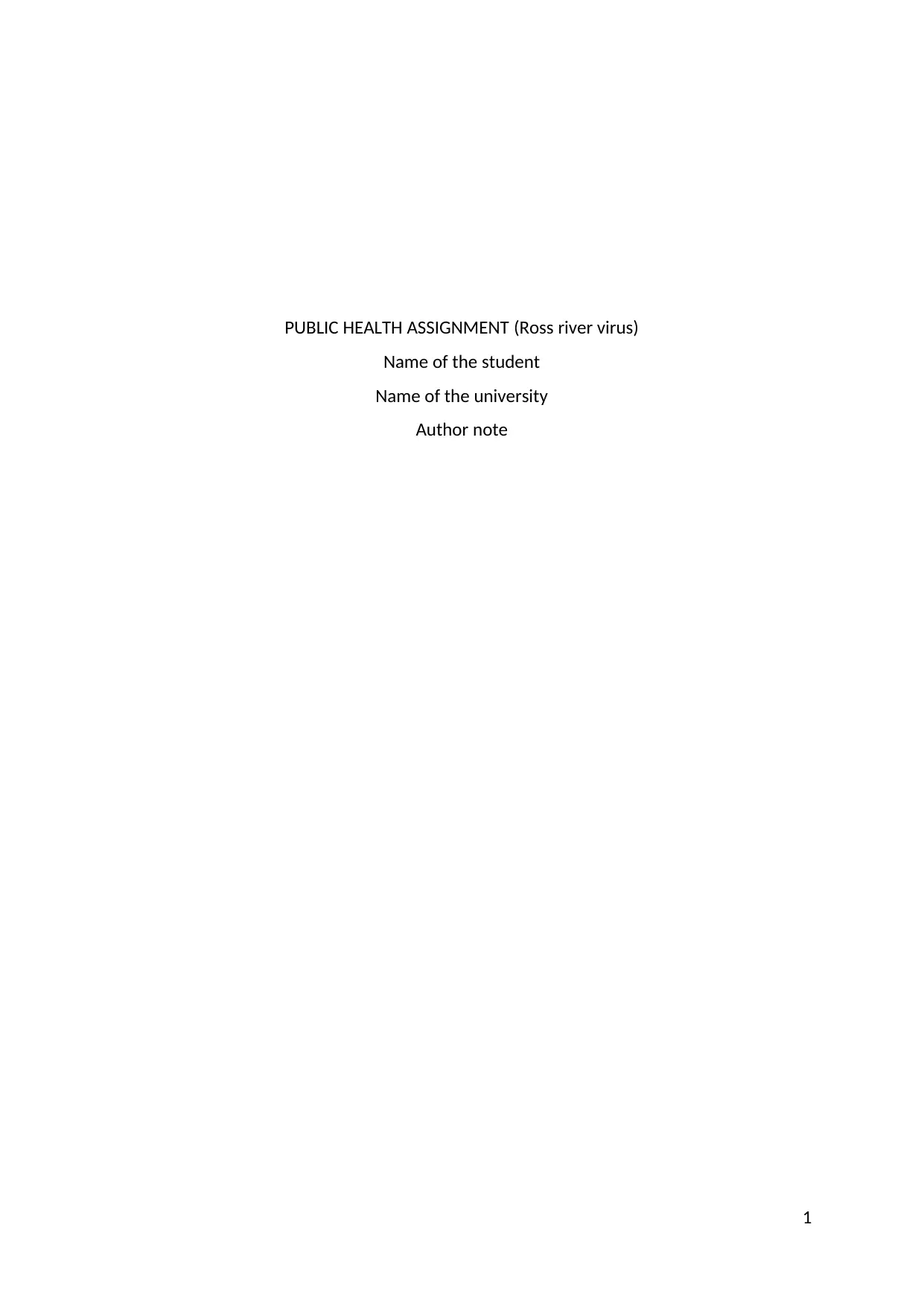
PUBLIC HEALTH ASSIGNMENT (Ross river virus)
Name of the student
Name of the university
Author note
1
Name of the student
Name of the university
Author note
1
Secure Best Marks with AI Grader
Need help grading? Try our AI Grader for instant feedback on your assignments.
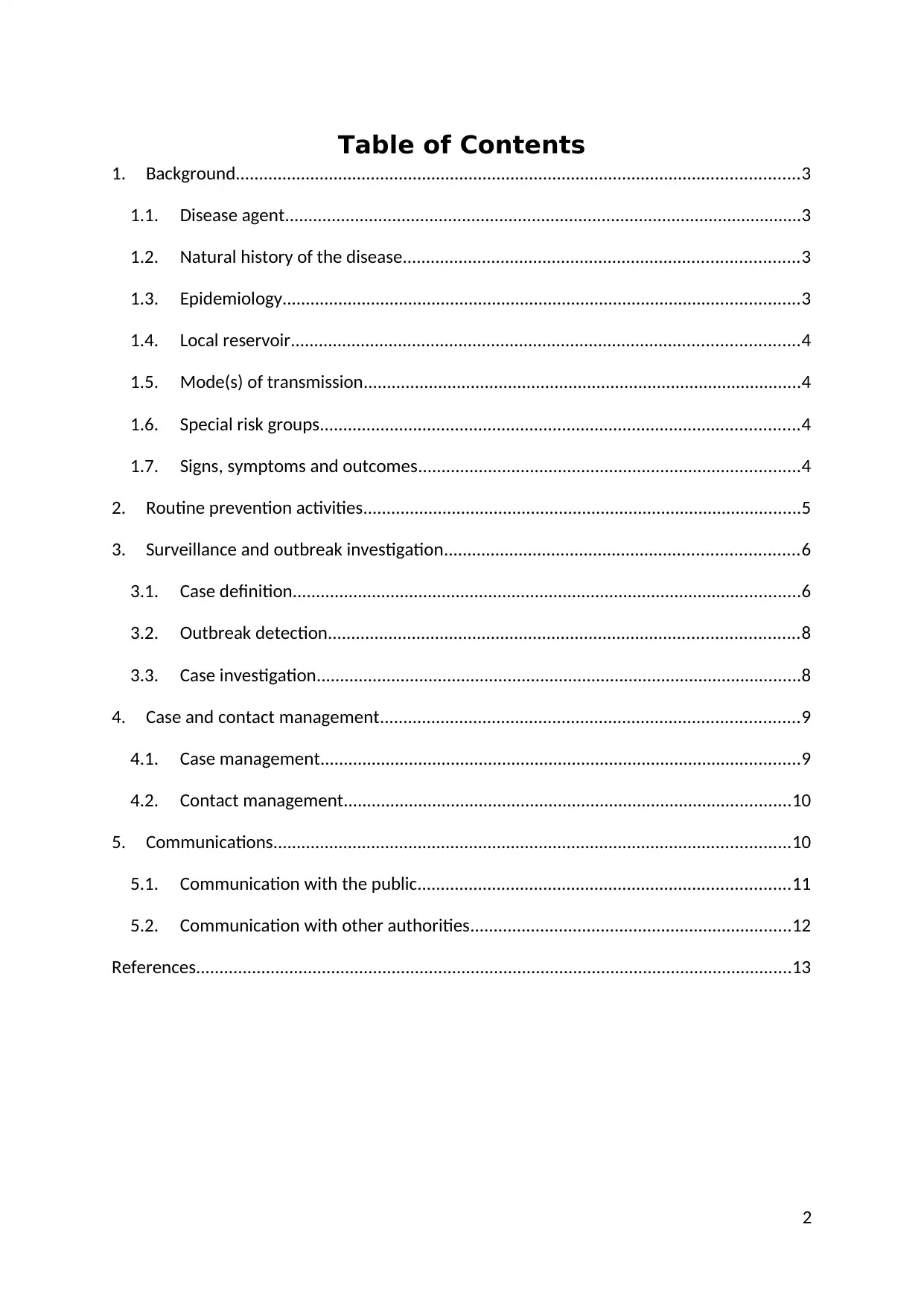
Table of Contents
1. Background.........................................................................................................................3
1.1. Disease agent...............................................................................................................3
1.2. Natural history of the disease.....................................................................................3
1.3. Epidemiology...............................................................................................................3
1.4. Local reservoir.............................................................................................................4
1.5. Mode(s) of transmission..............................................................................................4
1.6. Special risk groups.......................................................................................................4
1.7. Signs, symptoms and outcomes..................................................................................4
2. Routine prevention activities..............................................................................................5
3. Surveillance and outbreak investigation............................................................................6
3.1. Case definition.............................................................................................................6
3.2. Outbreak detection.....................................................................................................8
3.3. Case investigation........................................................................................................8
4. Case and contact management..........................................................................................9
4.1. Case management.......................................................................................................9
4.2. Contact management................................................................................................10
5. Communications...............................................................................................................10
5.1. Communication with the public................................................................................11
5.2. Communication with other authorities.....................................................................12
References................................................................................................................................13
2
1. Background.........................................................................................................................3
1.1. Disease agent...............................................................................................................3
1.2. Natural history of the disease.....................................................................................3
1.3. Epidemiology...............................................................................................................3
1.4. Local reservoir.............................................................................................................4
1.5. Mode(s) of transmission..............................................................................................4
1.6. Special risk groups.......................................................................................................4
1.7. Signs, symptoms and outcomes..................................................................................4
2. Routine prevention activities..............................................................................................5
3. Surveillance and outbreak investigation............................................................................6
3.1. Case definition.............................................................................................................6
3.2. Outbreak detection.....................................................................................................8
3.3. Case investigation........................................................................................................8
4. Case and contact management..........................................................................................9
4.1. Case management.......................................................................................................9
4.2. Contact management................................................................................................10
5. Communications...............................................................................................................10
5.1. Communication with the public................................................................................11
5.2. Communication with other authorities.....................................................................12
References................................................................................................................................13
2
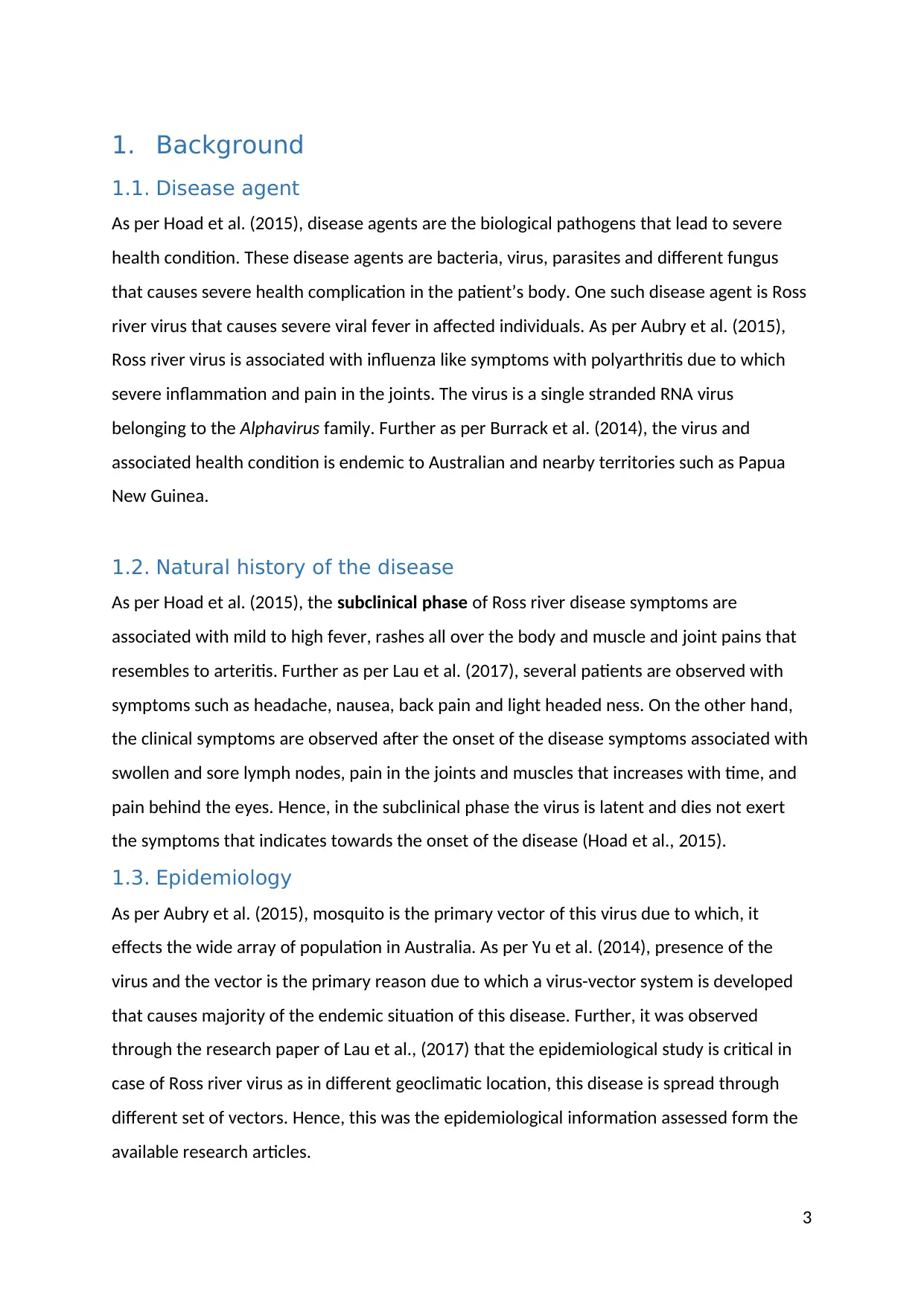
1. Background
1.1. Disease agent
As per Hoad et al. (2015), disease agents are the biological pathogens that lead to severe
health condition. These disease agents are bacteria, virus, parasites and different fungus
that causes severe health complication in the patient’s body. One such disease agent is Ross
river virus that causes severe viral fever in affected individuals. As per Aubry et al. (2015),
Ross river virus is associated with influenza like symptoms with polyarthritis due to which
severe inflammation and pain in the joints. The virus is a single stranded RNA virus
belonging to the Alphavirus family. Further as per Burrack et al. (2014), the virus and
associated health condition is endemic to Australian and nearby territories such as Papua
New Guinea.
1.2. Natural history of the disease
As per Hoad et al. (2015), the subclinical phase of Ross river disease symptoms are
associated with mild to high fever, rashes all over the body and muscle and joint pains that
resembles to arteritis. Further as per Lau et al. (2017), several patients are observed with
symptoms such as headache, nausea, back pain and light headed ness. On the other hand,
the clinical symptoms are observed after the onset of the disease symptoms associated with
swollen and sore lymph nodes, pain in the joints and muscles that increases with time, and
pain behind the eyes. Hence, in the subclinical phase the virus is latent and dies not exert
the symptoms that indicates towards the onset of the disease (Hoad et al., 2015).
1.3. Epidemiology
As per Aubry et al. (2015), mosquito is the primary vector of this virus due to which, it
effects the wide array of population in Australia. As per Yu et al. (2014), presence of the
virus and the vector is the primary reason due to which a virus-vector system is developed
that causes majority of the endemic situation of this disease. Further, it was observed
through the research paper of Lau et al., (2017) that the epidemiological study is critical in
case of Ross river virus as in different geoclimatic location, this disease is spread through
different set of vectors. Hence, this was the epidemiological information assessed form the
available research articles.
3
1.1. Disease agent
As per Hoad et al. (2015), disease agents are the biological pathogens that lead to severe
health condition. These disease agents are bacteria, virus, parasites and different fungus
that causes severe health complication in the patient’s body. One such disease agent is Ross
river virus that causes severe viral fever in affected individuals. As per Aubry et al. (2015),
Ross river virus is associated with influenza like symptoms with polyarthritis due to which
severe inflammation and pain in the joints. The virus is a single stranded RNA virus
belonging to the Alphavirus family. Further as per Burrack et al. (2014), the virus and
associated health condition is endemic to Australian and nearby territories such as Papua
New Guinea.
1.2. Natural history of the disease
As per Hoad et al. (2015), the subclinical phase of Ross river disease symptoms are
associated with mild to high fever, rashes all over the body and muscle and joint pains that
resembles to arteritis. Further as per Lau et al. (2017), several patients are observed with
symptoms such as headache, nausea, back pain and light headed ness. On the other hand,
the clinical symptoms are observed after the onset of the disease symptoms associated with
swollen and sore lymph nodes, pain in the joints and muscles that increases with time, and
pain behind the eyes. Hence, in the subclinical phase the virus is latent and dies not exert
the symptoms that indicates towards the onset of the disease (Hoad et al., 2015).
1.3. Epidemiology
As per Aubry et al. (2015), mosquito is the primary vector of this virus due to which, it
effects the wide array of population in Australia. As per Yu et al. (2014), presence of the
virus and the vector is the primary reason due to which a virus-vector system is developed
that causes majority of the endemic situation of this disease. Further, it was observed
through the research paper of Lau et al., (2017) that the epidemiological study is critical in
case of Ross river virus as in different geoclimatic location, this disease is spread through
different set of vectors. Hence, this was the epidemiological information assessed form the
available research articles.
3
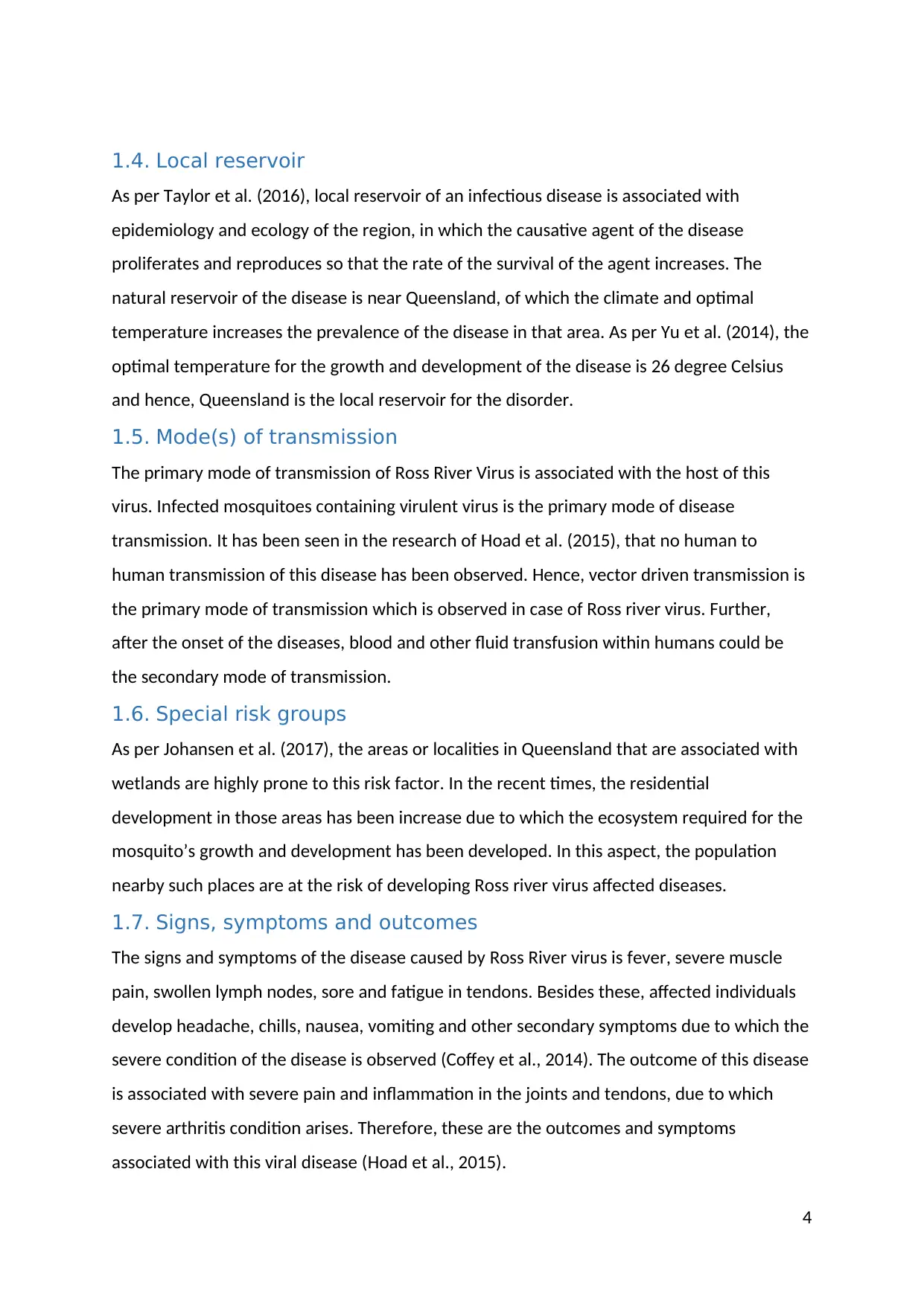
1.4. Local reservoir
As per Taylor et al. (2016), local reservoir of an infectious disease is associated with
epidemiology and ecology of the region, in which the causative agent of the disease
proliferates and reproduces so that the rate of the survival of the agent increases. The
natural reservoir of the disease is near Queensland, of which the climate and optimal
temperature increases the prevalence of the disease in that area. As per Yu et al. (2014), the
optimal temperature for the growth and development of the disease is 26 degree Celsius
and hence, Queensland is the local reservoir for the disorder.
1.5. Mode(s) of transmission
The primary mode of transmission of Ross River Virus is associated with the host of this
virus. Infected mosquitoes containing virulent virus is the primary mode of disease
transmission. It has been seen in the research of Hoad et al. (2015), that no human to
human transmission of this disease has been observed. Hence, vector driven transmission is
the primary mode of transmission which is observed in case of Ross river virus. Further,
after the onset of the diseases, blood and other fluid transfusion within humans could be
the secondary mode of transmission.
1.6. Special risk groups
As per Johansen et al. (2017), the areas or localities in Queensland that are associated with
wetlands are highly prone to this risk factor. In the recent times, the residential
development in those areas has been increase due to which the ecosystem required for the
mosquito’s growth and development has been developed. In this aspect, the population
nearby such places are at the risk of developing Ross river virus affected diseases.
1.7. Signs, symptoms and outcomes
The signs and symptoms of the disease caused by Ross River virus is fever, severe muscle
pain, swollen lymph nodes, sore and fatigue in tendons. Besides these, affected individuals
develop headache, chills, nausea, vomiting and other secondary symptoms due to which the
severe condition of the disease is observed (Coffey et al., 2014). The outcome of this disease
is associated with severe pain and inflammation in the joints and tendons, due to which
severe arthritis condition arises. Therefore, these are the outcomes and symptoms
associated with this viral disease (Hoad et al., 2015).
4
As per Taylor et al. (2016), local reservoir of an infectious disease is associated with
epidemiology and ecology of the region, in which the causative agent of the disease
proliferates and reproduces so that the rate of the survival of the agent increases. The
natural reservoir of the disease is near Queensland, of which the climate and optimal
temperature increases the prevalence of the disease in that area. As per Yu et al. (2014), the
optimal temperature for the growth and development of the disease is 26 degree Celsius
and hence, Queensland is the local reservoir for the disorder.
1.5. Mode(s) of transmission
The primary mode of transmission of Ross River Virus is associated with the host of this
virus. Infected mosquitoes containing virulent virus is the primary mode of disease
transmission. It has been seen in the research of Hoad et al. (2015), that no human to
human transmission of this disease has been observed. Hence, vector driven transmission is
the primary mode of transmission which is observed in case of Ross river virus. Further,
after the onset of the diseases, blood and other fluid transfusion within humans could be
the secondary mode of transmission.
1.6. Special risk groups
As per Johansen et al. (2017), the areas or localities in Queensland that are associated with
wetlands are highly prone to this risk factor. In the recent times, the residential
development in those areas has been increase due to which the ecosystem required for the
mosquito’s growth and development has been developed. In this aspect, the population
nearby such places are at the risk of developing Ross river virus affected diseases.
1.7. Signs, symptoms and outcomes
The signs and symptoms of the disease caused by Ross River virus is fever, severe muscle
pain, swollen lymph nodes, sore and fatigue in tendons. Besides these, affected individuals
develop headache, chills, nausea, vomiting and other secondary symptoms due to which the
severe condition of the disease is observed (Coffey et al., 2014). The outcome of this disease
is associated with severe pain and inflammation in the joints and tendons, due to which
severe arthritis condition arises. Therefore, these are the outcomes and symptoms
associated with this viral disease (Hoad et al., 2015).
4
Secure Best Marks with AI Grader
Need help grading? Try our AI Grader for instant feedback on your assignments.
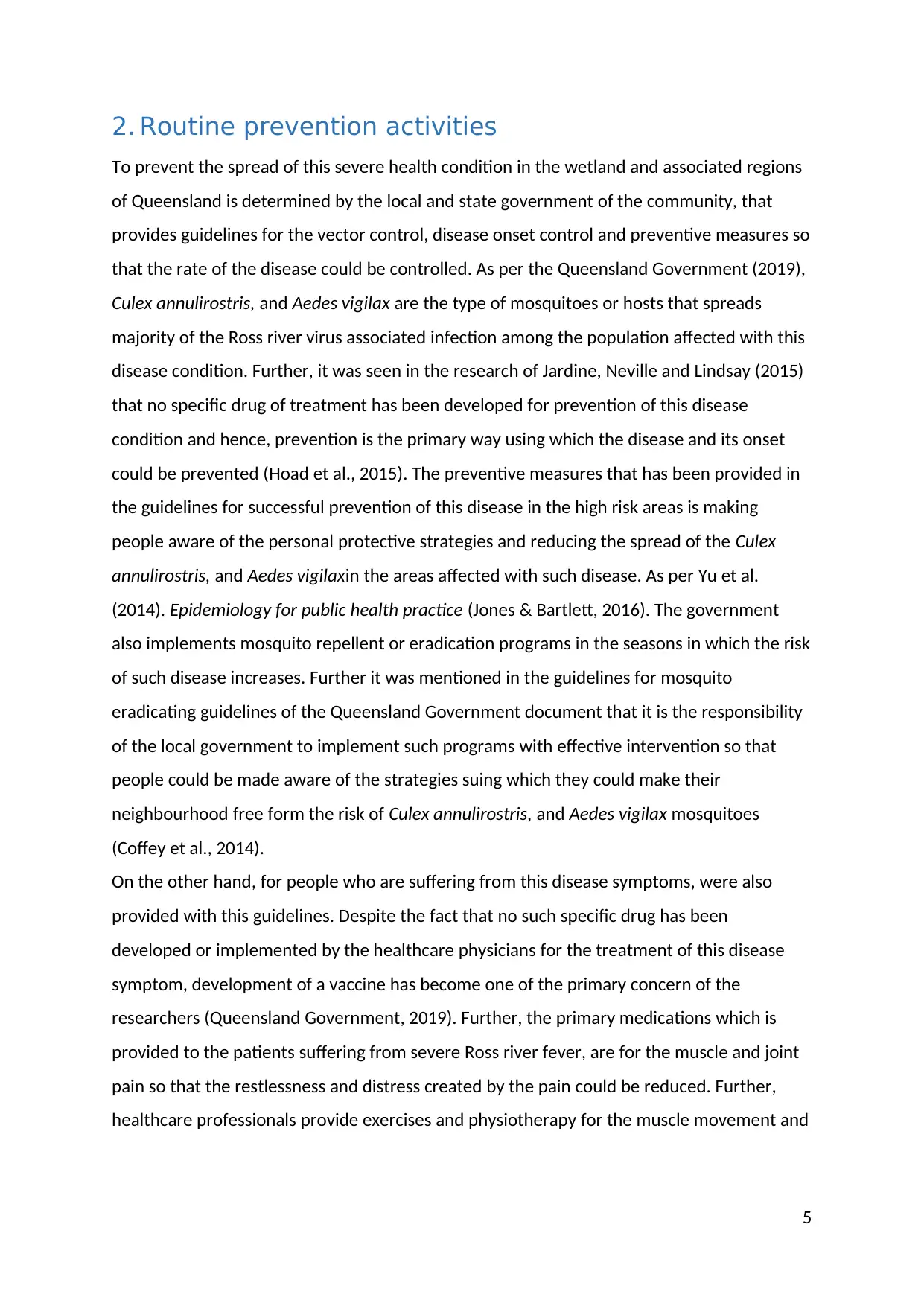
2. Routine prevention activities
To prevent the spread of this severe health condition in the wetland and associated regions
of Queensland is determined by the local and state government of the community, that
provides guidelines for the vector control, disease onset control and preventive measures so
that the rate of the disease could be controlled. As per the Queensland Government (2019),
Culex annulirostris, and Aedes vigilax are the type of mosquitoes or hosts that spreads
majority of the Ross river virus associated infection among the population affected with this
disease condition. Further, it was seen in the research of Jardine, Neville and Lindsay (2015)
that no specific drug of treatment has been developed for prevention of this disease
condition and hence, prevention is the primary way using which the disease and its onset
could be prevented (Hoad et al., 2015). The preventive measures that has been provided in
the guidelines for successful prevention of this disease in the high risk areas is making
people aware of the personal protective strategies and reducing the spread of the Culex
annulirostris, and Aedes vigilaxin the areas affected with such disease. As per Yu et al.
(2014). Epidemiology for public health practice (Jones & Bartlett, 2016). The government
also implements mosquito repellent or eradication programs in the seasons in which the risk
of such disease increases. Further it was mentioned in the guidelines for mosquito
eradicating guidelines of the Queensland Government document that it is the responsibility
of the local government to implement such programs with effective intervention so that
people could be made aware of the strategies suing which they could make their
neighbourhood free form the risk of Culex annulirostris, and Aedes vigilax mosquitoes
(Coffey et al., 2014).
On the other hand, for people who are suffering from this disease symptoms, were also
provided with this guidelines. Despite the fact that no such specific drug has been
developed or implemented by the healthcare physicians for the treatment of this disease
symptom, development of a vaccine has become one of the primary concern of the
researchers (Queensland Government, 2019). Further, the primary medications which is
provided to the patients suffering from severe Ross river fever, are for the muscle and joint
pain so that the restlessness and distress created by the pain could be reduced. Further,
healthcare professionals provide exercises and physiotherapy for the muscle movement and
5
To prevent the spread of this severe health condition in the wetland and associated regions
of Queensland is determined by the local and state government of the community, that
provides guidelines for the vector control, disease onset control and preventive measures so
that the rate of the disease could be controlled. As per the Queensland Government (2019),
Culex annulirostris, and Aedes vigilax are the type of mosquitoes or hosts that spreads
majority of the Ross river virus associated infection among the population affected with this
disease condition. Further, it was seen in the research of Jardine, Neville and Lindsay (2015)
that no specific drug of treatment has been developed for prevention of this disease
condition and hence, prevention is the primary way using which the disease and its onset
could be prevented (Hoad et al., 2015). The preventive measures that has been provided in
the guidelines for successful prevention of this disease in the high risk areas is making
people aware of the personal protective strategies and reducing the spread of the Culex
annulirostris, and Aedes vigilaxin the areas affected with such disease. As per Yu et al.
(2014). Epidemiology for public health practice (Jones & Bartlett, 2016). The government
also implements mosquito repellent or eradication programs in the seasons in which the risk
of such disease increases. Further it was mentioned in the guidelines for mosquito
eradicating guidelines of the Queensland Government document that it is the responsibility
of the local government to implement such programs with effective intervention so that
people could be made aware of the strategies suing which they could make their
neighbourhood free form the risk of Culex annulirostris, and Aedes vigilax mosquitoes
(Coffey et al., 2014).
On the other hand, for people who are suffering from this disease symptoms, were also
provided with this guidelines. Despite the fact that no such specific drug has been
developed or implemented by the healthcare physicians for the treatment of this disease
symptom, development of a vaccine has become one of the primary concern of the
researchers (Queensland Government, 2019). Further, the primary medications which is
provided to the patients suffering from severe Ross river fever, are for the muscle and joint
pain so that the restlessness and distress created by the pain could be reduced. Further,
healthcare professionals provide exercises and physiotherapy for the muscle movement and
5
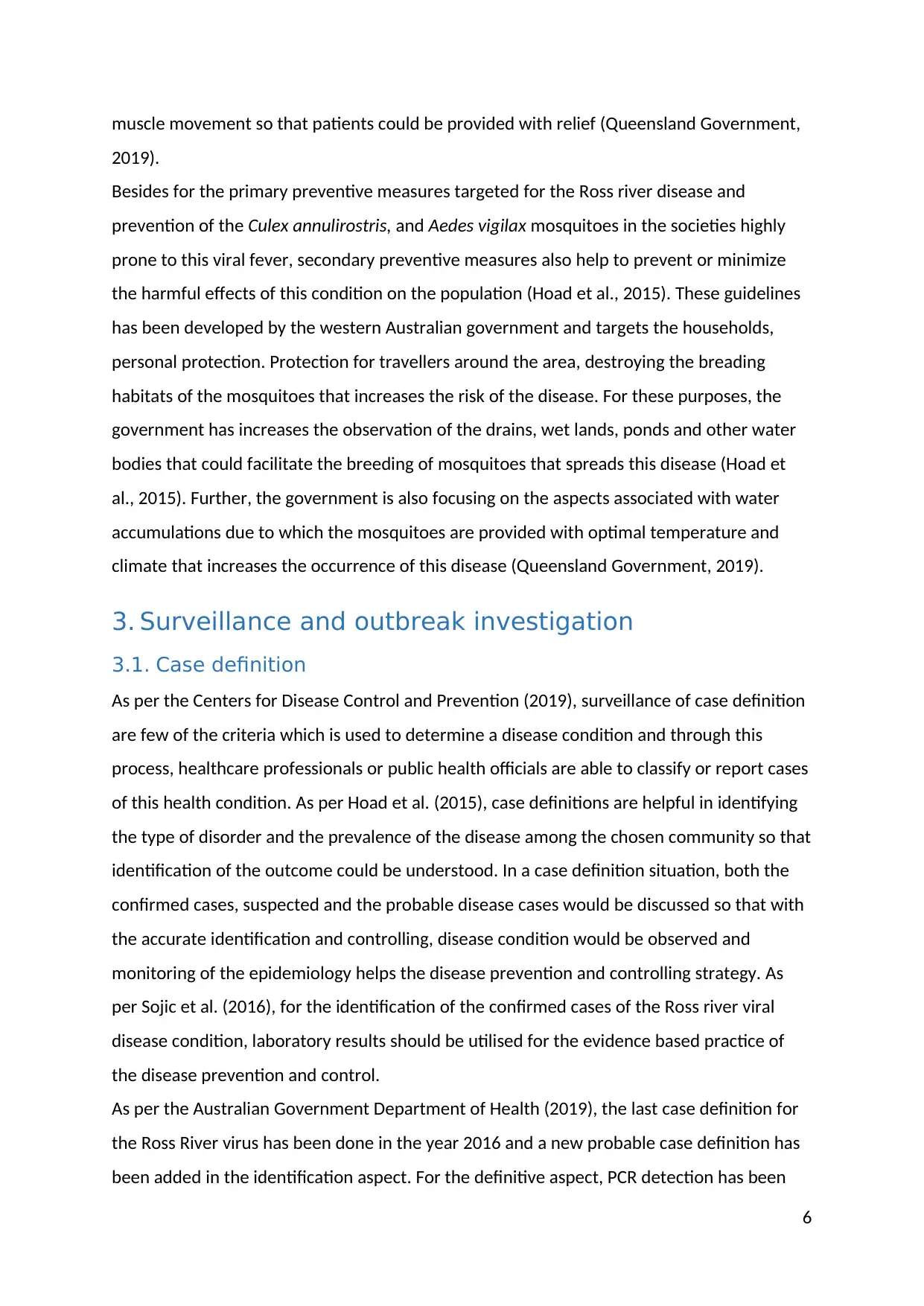
muscle movement so that patients could be provided with relief (Queensland Government,
2019).
Besides for the primary preventive measures targeted for the Ross river disease and
prevention of the Culex annulirostris, and Aedes vigilax mosquitoes in the societies highly
prone to this viral fever, secondary preventive measures also help to prevent or minimize
the harmful effects of this condition on the population (Hoad et al., 2015). These guidelines
has been developed by the western Australian government and targets the households,
personal protection. Protection for travellers around the area, destroying the breading
habitats of the mosquitoes that increases the risk of the disease. For these purposes, the
government has increases the observation of the drains, wet lands, ponds and other water
bodies that could facilitate the breeding of mosquitoes that spreads this disease (Hoad et
al., 2015). Further, the government is also focusing on the aspects associated with water
accumulations due to which the mosquitoes are provided with optimal temperature and
climate that increases the occurrence of this disease (Queensland Government, 2019).
3. Surveillance and outbreak investigation
3.1. Case definition
As per the Centers for Disease Control and Prevention (2019), surveillance of case definition
are few of the criteria which is used to determine a disease condition and through this
process, healthcare professionals or public health officials are able to classify or report cases
of this health condition. As per Hoad et al. (2015), case definitions are helpful in identifying
the type of disorder and the prevalence of the disease among the chosen community so that
identification of the outcome could be understood. In a case definition situation, both the
confirmed cases, suspected and the probable disease cases would be discussed so that with
the accurate identification and controlling, disease condition would be observed and
monitoring of the epidemiology helps the disease prevention and controlling strategy. As
per Sojic et al. (2016), for the identification of the confirmed cases of the Ross river viral
disease condition, laboratory results should be utilised for the evidence based practice of
the disease prevention and control.
As per the Australian Government Department of Health (2019), the last case definition for
the Ross River virus has been done in the year 2016 and a new probable case definition has
been added in the identification aspect. For the definitive aspect, PCR detection has been
6
2019).
Besides for the primary preventive measures targeted for the Ross river disease and
prevention of the Culex annulirostris, and Aedes vigilax mosquitoes in the societies highly
prone to this viral fever, secondary preventive measures also help to prevent or minimize
the harmful effects of this condition on the population (Hoad et al., 2015). These guidelines
has been developed by the western Australian government and targets the households,
personal protection. Protection for travellers around the area, destroying the breading
habitats of the mosquitoes that increases the risk of the disease. For these purposes, the
government has increases the observation of the drains, wet lands, ponds and other water
bodies that could facilitate the breeding of mosquitoes that spreads this disease (Hoad et
al., 2015). Further, the government is also focusing on the aspects associated with water
accumulations due to which the mosquitoes are provided with optimal temperature and
climate that increases the occurrence of this disease (Queensland Government, 2019).
3. Surveillance and outbreak investigation
3.1. Case definition
As per the Centers for Disease Control and Prevention (2019), surveillance of case definition
are few of the criteria which is used to determine a disease condition and through this
process, healthcare professionals or public health officials are able to classify or report cases
of this health condition. As per Hoad et al. (2015), case definitions are helpful in identifying
the type of disorder and the prevalence of the disease among the chosen community so that
identification of the outcome could be understood. In a case definition situation, both the
confirmed cases, suspected and the probable disease cases would be discussed so that with
the accurate identification and controlling, disease condition would be observed and
monitoring of the epidemiology helps the disease prevention and controlling strategy. As
per Sojic et al. (2016), for the identification of the confirmed cases of the Ross river viral
disease condition, laboratory results should be utilised for the evidence based practice of
the disease prevention and control.
As per the Australian Government Department of Health (2019), the last case definition for
the Ross River virus has been done in the year 2016 and a new probable case definition has
been added in the identification aspect. For the definitive aspect, PCR detection has been
6
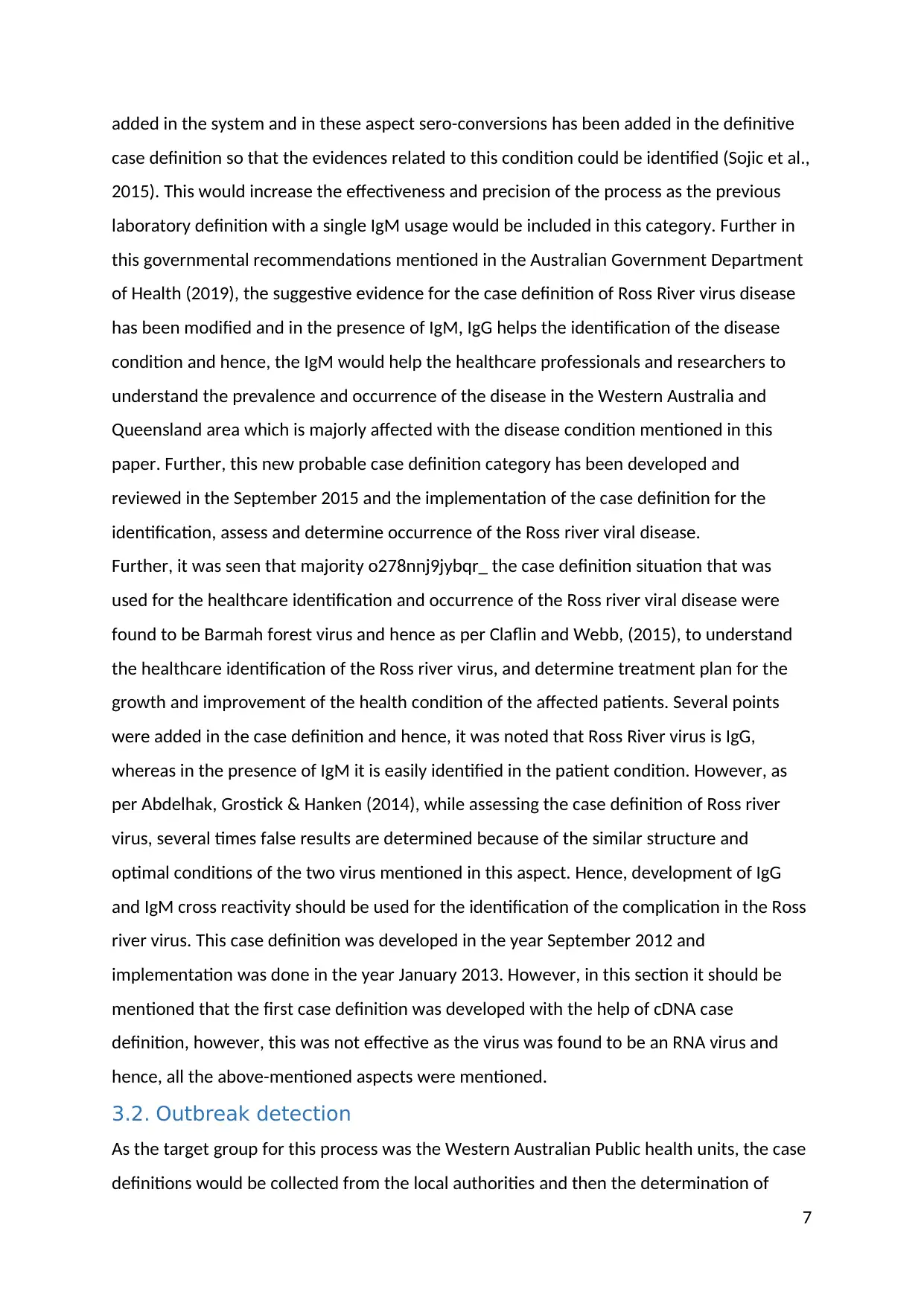
added in the system and in these aspect sero-conversions has been added in the definitive
case definition so that the evidences related to this condition could be identified (Sojic et al.,
2015). This would increase the effectiveness and precision of the process as the previous
laboratory definition with a single IgM usage would be included in this category. Further in
this governmental recommendations mentioned in the Australian Government Department
of Health (2019), the suggestive evidence for the case definition of Ross River virus disease
has been modified and in the presence of IgM, IgG helps the identification of the disease
condition and hence, the IgM would help the healthcare professionals and researchers to
understand the prevalence and occurrence of the disease in the Western Australia and
Queensland area which is majorly affected with the disease condition mentioned in this
paper. Further, this new probable case definition category has been developed and
reviewed in the September 2015 and the implementation of the case definition for the
identification, assess and determine occurrence of the Ross river viral disease.
Further, it was seen that majority o278nnj9jybqr_ the case definition situation that was
used for the healthcare identification and occurrence of the Ross river viral disease were
found to be Barmah forest virus and hence as per Claflin and Webb, (2015), to understand
the healthcare identification of the Ross river virus, and determine treatment plan for the
growth and improvement of the health condition of the affected patients. Several points
were added in the case definition and hence, it was noted that Ross River virus is IgG,
whereas in the presence of IgM it is easily identified in the patient condition. However, as
per Abdelhak, Grostick & Hanken (2014), while assessing the case definition of Ross river
virus, several times false results are determined because of the similar structure and
optimal conditions of the two virus mentioned in this aspect. Hence, development of IgG
and IgM cross reactivity should be used for the identification of the complication in the Ross
river virus. This case definition was developed in the year September 2012 and
implementation was done in the year January 2013. However, in this section it should be
mentioned that the first case definition was developed with the help of cDNA case
definition, however, this was not effective as the virus was found to be an RNA virus and
hence, all the above-mentioned aspects were mentioned.
3.2. Outbreak detection
As the target group for this process was the Western Australian Public health units, the case
definitions would be collected from the local authorities and then the determination of
7
case definition so that the evidences related to this condition could be identified (Sojic et al.,
2015). This would increase the effectiveness and precision of the process as the previous
laboratory definition with a single IgM usage would be included in this category. Further in
this governmental recommendations mentioned in the Australian Government Department
of Health (2019), the suggestive evidence for the case definition of Ross River virus disease
has been modified and in the presence of IgM, IgG helps the identification of the disease
condition and hence, the IgM would help the healthcare professionals and researchers to
understand the prevalence and occurrence of the disease in the Western Australia and
Queensland area which is majorly affected with the disease condition mentioned in this
paper. Further, this new probable case definition category has been developed and
reviewed in the September 2015 and the implementation of the case definition for the
identification, assess and determine occurrence of the Ross river viral disease.
Further, it was seen that majority o278nnj9jybqr_ the case definition situation that was
used for the healthcare identification and occurrence of the Ross river viral disease were
found to be Barmah forest virus and hence as per Claflin and Webb, (2015), to understand
the healthcare identification of the Ross river virus, and determine treatment plan for the
growth and improvement of the health condition of the affected patients. Several points
were added in the case definition and hence, it was noted that Ross River virus is IgG,
whereas in the presence of IgM it is easily identified in the patient condition. However, as
per Abdelhak, Grostick & Hanken (2014), while assessing the case definition of Ross river
virus, several times false results are determined because of the similar structure and
optimal conditions of the two virus mentioned in this aspect. Hence, development of IgG
and IgM cross reactivity should be used for the identification of the complication in the Ross
river virus. This case definition was developed in the year September 2012 and
implementation was done in the year January 2013. However, in this section it should be
mentioned that the first case definition was developed with the help of cDNA case
definition, however, this was not effective as the virus was found to be an RNA virus and
hence, all the above-mentioned aspects were mentioned.
3.2. Outbreak detection
As the target group for this process was the Western Australian Public health units, the case
definitions would be collected from the local authorities and then the determination of
7
Paraphrase This Document
Need a fresh take? Get an instant paraphrase of this document with our AI Paraphraser
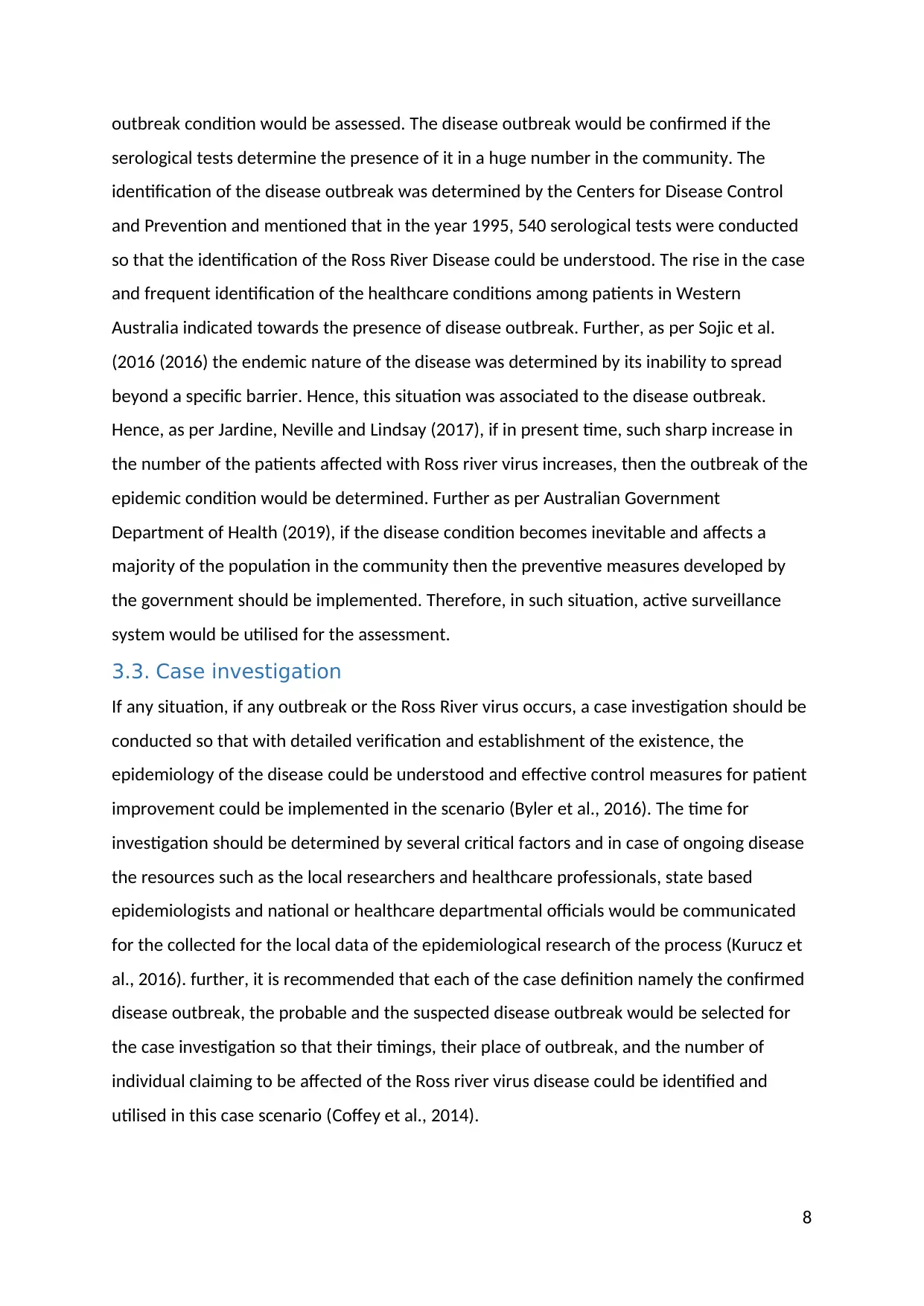
outbreak condition would be assessed. The disease outbreak would be confirmed if the
serological tests determine the presence of it in a huge number in the community. The
identification of the disease outbreak was determined by the Centers for Disease Control
and Prevention and mentioned that in the year 1995, 540 serological tests were conducted
so that the identification of the Ross River Disease could be understood. The rise in the case
and frequent identification of the healthcare conditions among patients in Western
Australia indicated towards the presence of disease outbreak. Further, as per Sojic et al.
(2016 (2016) the endemic nature of the disease was determined by its inability to spread
beyond a specific barrier. Hence, this situation was associated to the disease outbreak.
Hence, as per Jardine, Neville and Lindsay (2017), if in present time, such sharp increase in
the number of the patients affected with Ross river virus increases, then the outbreak of the
epidemic condition would be determined. Further as per Australian Government
Department of Health (2019), if the disease condition becomes inevitable and affects a
majority of the population in the community then the preventive measures developed by
the government should be implemented. Therefore, in such situation, active surveillance
system would be utilised for the assessment.
3.3. Case investigation
If any situation, if any outbreak or the Ross River virus occurs, a case investigation should be
conducted so that with detailed verification and establishment of the existence, the
epidemiology of the disease could be understood and effective control measures for patient
improvement could be implemented in the scenario (Byler et al., 2016). The time for
investigation should be determined by several critical factors and in case of ongoing disease
the resources such as the local researchers and healthcare professionals, state based
epidemiologists and national or healthcare departmental officials would be communicated
for the collected for the local data of the epidemiological research of the process (Kurucz et
al., 2016). further, it is recommended that each of the case definition namely the confirmed
disease outbreak, the probable and the suspected disease outbreak would be selected for
the case investigation so that their timings, their place of outbreak, and the number of
individual claiming to be affected of the Ross river virus disease could be identified and
utilised in this case scenario (Coffey et al., 2014).
8
serological tests determine the presence of it in a huge number in the community. The
identification of the disease outbreak was determined by the Centers for Disease Control
and Prevention and mentioned that in the year 1995, 540 serological tests were conducted
so that the identification of the Ross River Disease could be understood. The rise in the case
and frequent identification of the healthcare conditions among patients in Western
Australia indicated towards the presence of disease outbreak. Further, as per Sojic et al.
(2016 (2016) the endemic nature of the disease was determined by its inability to spread
beyond a specific barrier. Hence, this situation was associated to the disease outbreak.
Hence, as per Jardine, Neville and Lindsay (2017), if in present time, such sharp increase in
the number of the patients affected with Ross river virus increases, then the outbreak of the
epidemic condition would be determined. Further as per Australian Government
Department of Health (2019), if the disease condition becomes inevitable and affects a
majority of the population in the community then the preventive measures developed by
the government should be implemented. Therefore, in such situation, active surveillance
system would be utilised for the assessment.
3.3. Case investigation
If any situation, if any outbreak or the Ross River virus occurs, a case investigation should be
conducted so that with detailed verification and establishment of the existence, the
epidemiology of the disease could be understood and effective control measures for patient
improvement could be implemented in the scenario (Byler et al., 2016). The time for
investigation should be determined by several critical factors and in case of ongoing disease
the resources such as the local researchers and healthcare professionals, state based
epidemiologists and national or healthcare departmental officials would be communicated
for the collected for the local data of the epidemiological research of the process (Kurucz et
al., 2016). further, it is recommended that each of the case definition namely the confirmed
disease outbreak, the probable and the suspected disease outbreak would be selected for
the case investigation so that their timings, their place of outbreak, and the number of
individual claiming to be affected of the Ross river virus disease could be identified and
utilised in this case scenario (Coffey et al., 2014).
8
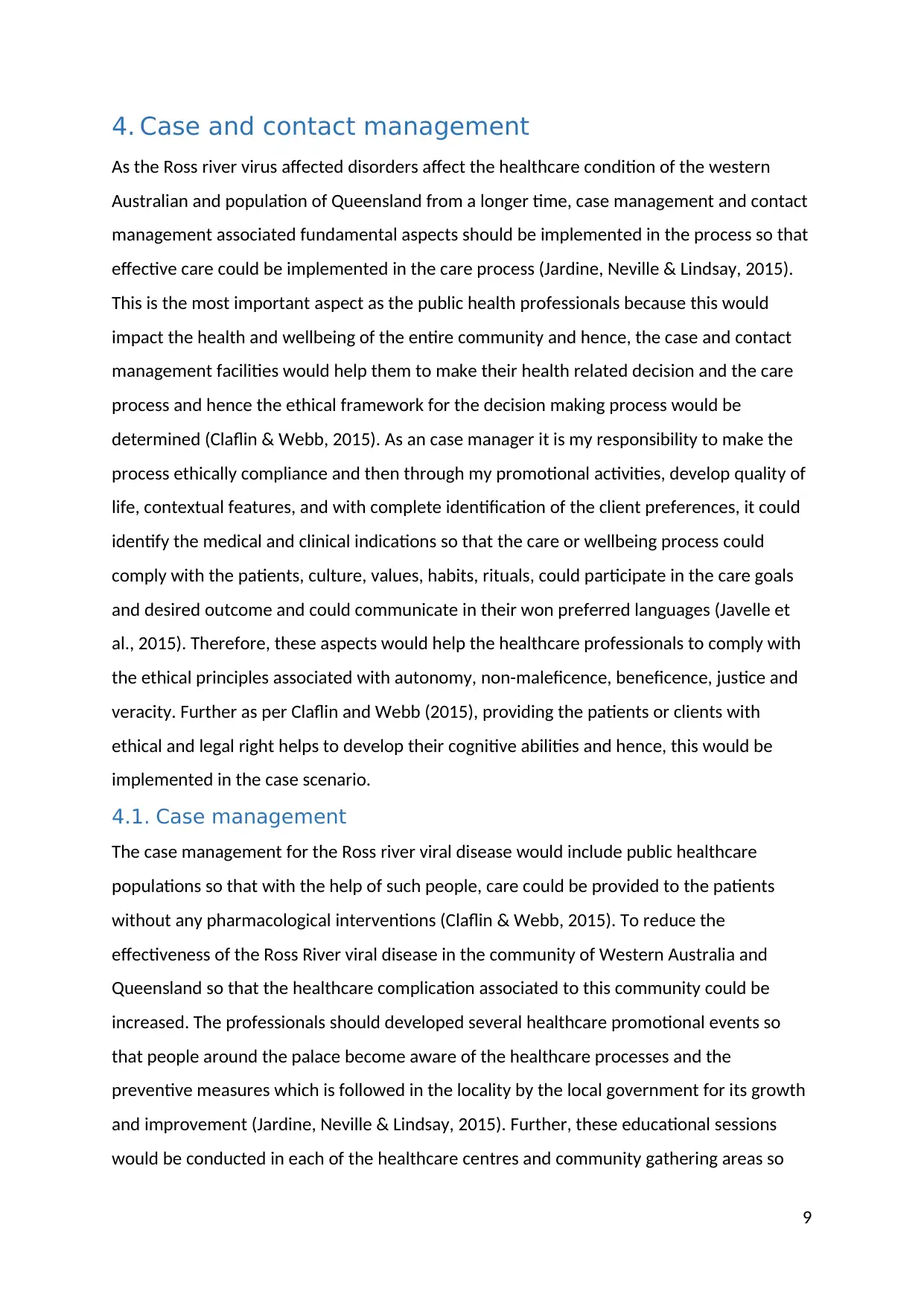
4. Case and contact management
As the Ross river virus affected disorders affect the healthcare condition of the western
Australian and population of Queensland from a longer time, case management and contact
management associated fundamental aspects should be implemented in the process so that
effective care could be implemented in the care process (Jardine, Neville & Lindsay, 2015).
This is the most important aspect as the public health professionals because this would
impact the health and wellbeing of the entire community and hence, the case and contact
management facilities would help them to make their health related decision and the care
process and hence the ethical framework for the decision making process would be
determined (Claflin & Webb, 2015). As an case manager it is my responsibility to make the
process ethically compliance and then through my promotional activities, develop quality of
life, contextual features, and with complete identification of the client preferences, it could
identify the medical and clinical indications so that the care or wellbeing process could
comply with the patients, culture, values, habits, rituals, could participate in the care goals
and desired outcome and could communicate in their won preferred languages (Javelle et
al., 2015). Therefore, these aspects would help the healthcare professionals to comply with
the ethical principles associated with autonomy, non-maleficence, beneficence, justice and
veracity. Further as per Claflin and Webb (2015), providing the patients or clients with
ethical and legal right helps to develop their cognitive abilities and hence, this would be
implemented in the case scenario.
4.1. Case management
The case management for the Ross river viral disease would include public healthcare
populations so that with the help of such people, care could be provided to the patients
without any pharmacological interventions (Claflin & Webb, 2015). To reduce the
effectiveness of the Ross River viral disease in the community of Western Australia and
Queensland so that the healthcare complication associated to this community could be
increased. The professionals should developed several healthcare promotional events so
that people around the palace become aware of the healthcare processes and the
preventive measures which is followed in the locality by the local government for its growth
and improvement (Jardine, Neville & Lindsay, 2015). Further, these educational sessions
would be conducted in each of the healthcare centres and community gathering areas so
9
As the Ross river virus affected disorders affect the healthcare condition of the western
Australian and population of Queensland from a longer time, case management and contact
management associated fundamental aspects should be implemented in the process so that
effective care could be implemented in the care process (Jardine, Neville & Lindsay, 2015).
This is the most important aspect as the public health professionals because this would
impact the health and wellbeing of the entire community and hence, the case and contact
management facilities would help them to make their health related decision and the care
process and hence the ethical framework for the decision making process would be
determined (Claflin & Webb, 2015). As an case manager it is my responsibility to make the
process ethically compliance and then through my promotional activities, develop quality of
life, contextual features, and with complete identification of the client preferences, it could
identify the medical and clinical indications so that the care or wellbeing process could
comply with the patients, culture, values, habits, rituals, could participate in the care goals
and desired outcome and could communicate in their won preferred languages (Javelle et
al., 2015). Therefore, these aspects would help the healthcare professionals to comply with
the ethical principles associated with autonomy, non-maleficence, beneficence, justice and
veracity. Further as per Claflin and Webb (2015), providing the patients or clients with
ethical and legal right helps to develop their cognitive abilities and hence, this would be
implemented in the case scenario.
4.1. Case management
The case management for the Ross river viral disease would include public healthcare
populations so that with the help of such people, care could be provided to the patients
without any pharmacological interventions (Claflin & Webb, 2015). To reduce the
effectiveness of the Ross River viral disease in the community of Western Australia and
Queensland so that the healthcare complication associated to this community could be
increased. The professionals should developed several healthcare promotional events so
that people around the palace become aware of the healthcare processes and the
preventive measures which is followed in the locality by the local government for its growth
and improvement (Jardine, Neville & Lindsay, 2015). Further, these educational sessions
would be conducted in each of the healthcare centres and community gathering areas so
9
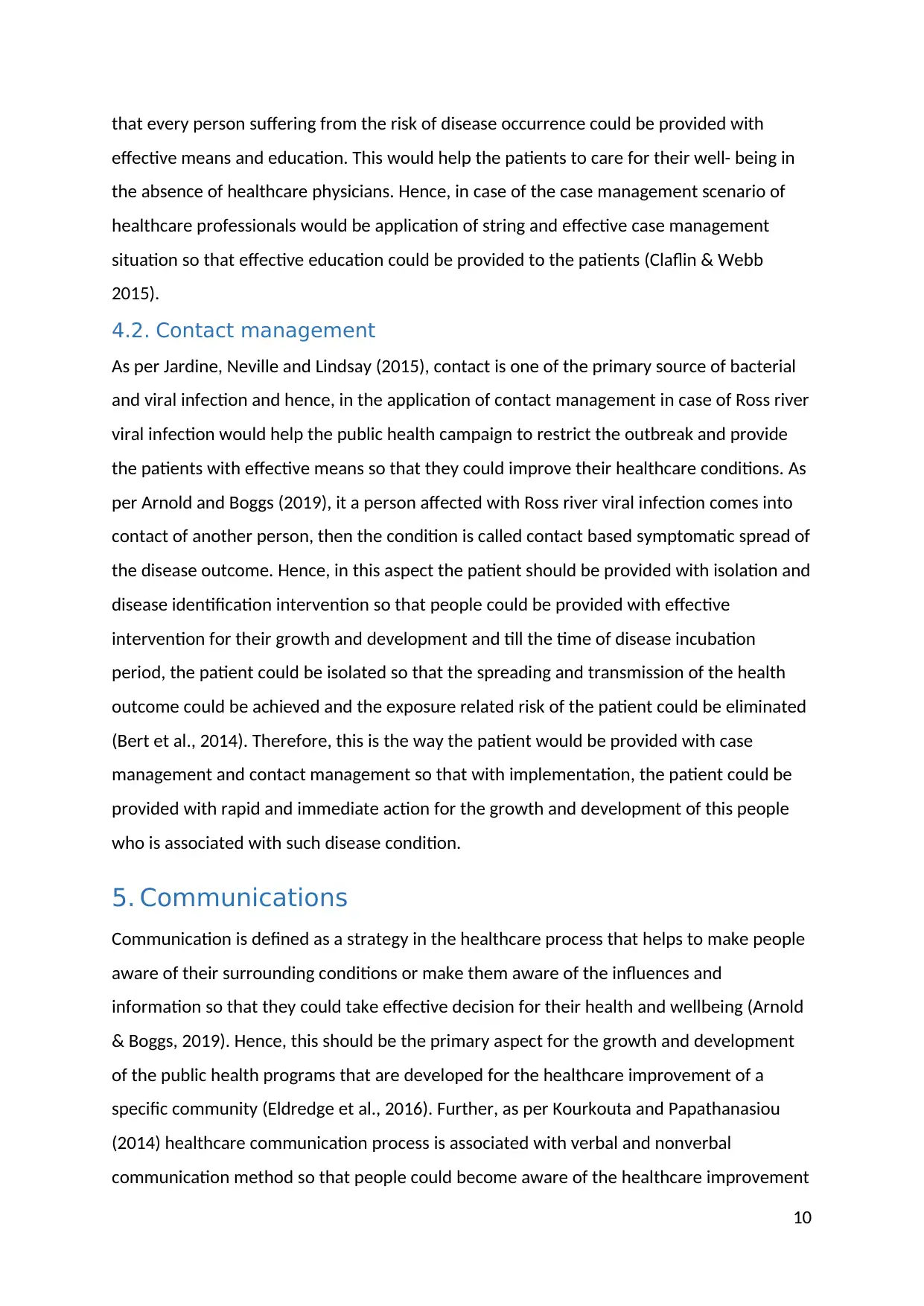
that every person suffering from the risk of disease occurrence could be provided with
effective means and education. This would help the patients to care for their well- being in
the absence of healthcare physicians. Hence, in case of the case management scenario of
healthcare professionals would be application of string and effective case management
situation so that effective education could be provided to the patients (Claflin & Webb
2015).
4.2. Contact management
As per Jardine, Neville and Lindsay (2015), contact is one of the primary source of bacterial
and viral infection and hence, in the application of contact management in case of Ross river
viral infection would help the public health campaign to restrict the outbreak and provide
the patients with effective means so that they could improve their healthcare conditions. As
per Arnold and Boggs (2019), it a person affected with Ross river viral infection comes into
contact of another person, then the condition is called contact based symptomatic spread of
the disease outcome. Hence, in this aspect the patient should be provided with isolation and
disease identification intervention so that people could be provided with effective
intervention for their growth and development and till the time of disease incubation
period, the patient could be isolated so that the spreading and transmission of the health
outcome could be achieved and the exposure related risk of the patient could be eliminated
(Bert et al., 2014). Therefore, this is the way the patient would be provided with case
management and contact management so that with implementation, the patient could be
provided with rapid and immediate action for the growth and development of this people
who is associated with such disease condition.
5. Communications
Communication is defined as a strategy in the healthcare process that helps to make people
aware of their surrounding conditions or make them aware of the influences and
information so that they could take effective decision for their health and wellbeing (Arnold
& Boggs, 2019). Hence, this should be the primary aspect for the growth and development
of the public health programs that are developed for the healthcare improvement of a
specific community (Eldredge et al., 2016). Further, as per Kourkouta and Papathanasiou
(2014) healthcare communication process is associated with verbal and nonverbal
communication method so that people could become aware of the healthcare improvement
10
effective means and education. This would help the patients to care for their well- being in
the absence of healthcare physicians. Hence, in case of the case management scenario of
healthcare professionals would be application of string and effective case management
situation so that effective education could be provided to the patients (Claflin & Webb
2015).
4.2. Contact management
As per Jardine, Neville and Lindsay (2015), contact is one of the primary source of bacterial
and viral infection and hence, in the application of contact management in case of Ross river
viral infection would help the public health campaign to restrict the outbreak and provide
the patients with effective means so that they could improve their healthcare conditions. As
per Arnold and Boggs (2019), it a person affected with Ross river viral infection comes into
contact of another person, then the condition is called contact based symptomatic spread of
the disease outcome. Hence, in this aspect the patient should be provided with isolation and
disease identification intervention so that people could be provided with effective
intervention for their growth and development and till the time of disease incubation
period, the patient could be isolated so that the spreading and transmission of the health
outcome could be achieved and the exposure related risk of the patient could be eliminated
(Bert et al., 2014). Therefore, this is the way the patient would be provided with case
management and contact management so that with implementation, the patient could be
provided with rapid and immediate action for the growth and development of this people
who is associated with such disease condition.
5. Communications
Communication is defined as a strategy in the healthcare process that helps to make people
aware of their surrounding conditions or make them aware of the influences and
information so that they could take effective decision for their health and wellbeing (Arnold
& Boggs, 2019). Hence, this should be the primary aspect for the growth and development
of the public health programs that are developed for the healthcare improvement of a
specific community (Eldredge et al., 2016). Further, as per Kourkouta and Papathanasiou
(2014) healthcare communication process is associated with verbal and nonverbal
communication method so that people could become aware of the healthcare improvement
10
Secure Best Marks with AI Grader
Need help grading? Try our AI Grader for instant feedback on your assignments.
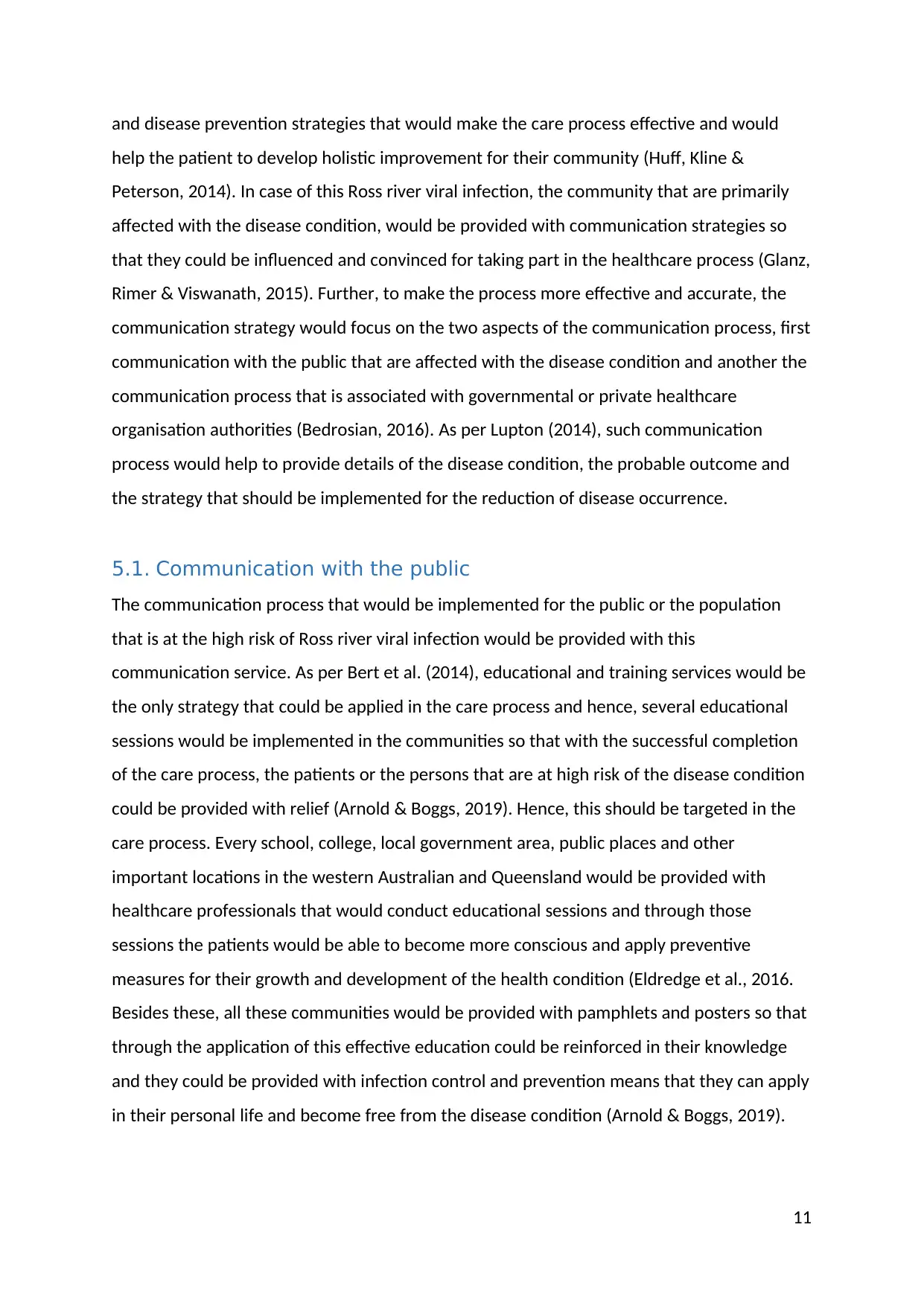
and disease prevention strategies that would make the care process effective and would
help the patient to develop holistic improvement for their community (Huff, Kline &
Peterson, 2014). In case of this Ross river viral infection, the community that are primarily
affected with the disease condition, would be provided with communication strategies so
that they could be influenced and convinced for taking part in the healthcare process (Glanz,
Rimer & Viswanath, 2015). Further, to make the process more effective and accurate, the
communication strategy would focus on the two aspects of the communication process, first
communication with the public that are affected with the disease condition and another the
communication process that is associated with governmental or private healthcare
organisation authorities (Bedrosian, 2016). As per Lupton (2014), such communication
process would help to provide details of the disease condition, the probable outcome and
the strategy that should be implemented for the reduction of disease occurrence.
5.1. Communication with the public
The communication process that would be implemented for the public or the population
that is at the high risk of Ross river viral infection would be provided with this
communication service. As per Bert et al. (2014), educational and training services would be
the only strategy that could be applied in the care process and hence, several educational
sessions would be implemented in the communities so that with the successful completion
of the care process, the patients or the persons that are at high risk of the disease condition
could be provided with relief (Arnold & Boggs, 2019). Hence, this should be targeted in the
care process. Every school, college, local government area, public places and other
important locations in the western Australian and Queensland would be provided with
healthcare professionals that would conduct educational sessions and through those
sessions the patients would be able to become more conscious and apply preventive
measures for their growth and development of the health condition (Eldredge et al., 2016.
Besides these, all these communities would be provided with pamphlets and posters so that
through the application of this effective education could be reinforced in their knowledge
and they could be provided with infection control and prevention means that they can apply
in their personal life and become free from the disease condition (Arnold & Boggs, 2019).
11
help the patient to develop holistic improvement for their community (Huff, Kline &
Peterson, 2014). In case of this Ross river viral infection, the community that are primarily
affected with the disease condition, would be provided with communication strategies so
that they could be influenced and convinced for taking part in the healthcare process (Glanz,
Rimer & Viswanath, 2015). Further, to make the process more effective and accurate, the
communication strategy would focus on the two aspects of the communication process, first
communication with the public that are affected with the disease condition and another the
communication process that is associated with governmental or private healthcare
organisation authorities (Bedrosian, 2016). As per Lupton (2014), such communication
process would help to provide details of the disease condition, the probable outcome and
the strategy that should be implemented for the reduction of disease occurrence.
5.1. Communication with the public
The communication process that would be implemented for the public or the population
that is at the high risk of Ross river viral infection would be provided with this
communication service. As per Bert et al. (2014), educational and training services would be
the only strategy that could be applied in the care process and hence, several educational
sessions would be implemented in the communities so that with the successful completion
of the care process, the patients or the persons that are at high risk of the disease condition
could be provided with relief (Arnold & Boggs, 2019). Hence, this should be targeted in the
care process. Every school, college, local government area, public places and other
important locations in the western Australian and Queensland would be provided with
healthcare professionals that would conduct educational sessions and through those
sessions the patients would be able to become more conscious and apply preventive
measures for their growth and development of the health condition (Eldredge et al., 2016.
Besides these, all these communities would be provided with pamphlets and posters so that
through the application of this effective education could be reinforced in their knowledge
and they could be provided with infection control and prevention means that they can apply
in their personal life and become free from the disease condition (Arnold & Boggs, 2019).
11
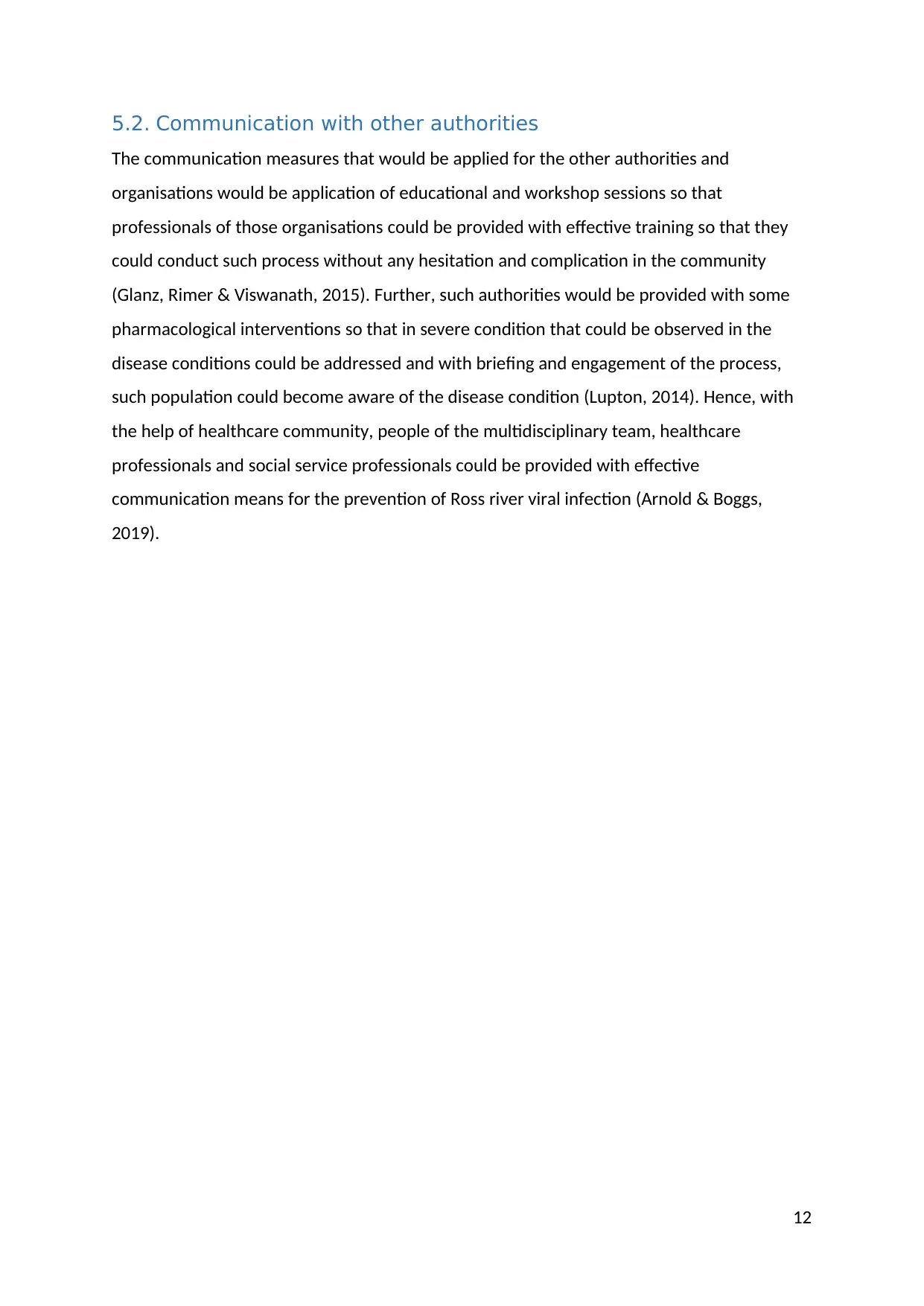
5.2. Communication with other authorities
The communication measures that would be applied for the other authorities and
organisations would be application of educational and workshop sessions so that
professionals of those organisations could be provided with effective training so that they
could conduct such process without any hesitation and complication in the community
(Glanz, Rimer & Viswanath, 2015). Further, such authorities would be provided with some
pharmacological interventions so that in severe condition that could be observed in the
disease conditions could be addressed and with briefing and engagement of the process,
such population could become aware of the disease condition (Lupton, 2014). Hence, with
the help of healthcare community, people of the multidisciplinary team, healthcare
professionals and social service professionals could be provided with effective
communication means for the prevention of Ross river viral infection (Arnold & Boggs,
2019).
12
The communication measures that would be applied for the other authorities and
organisations would be application of educational and workshop sessions so that
professionals of those organisations could be provided with effective training so that they
could conduct such process without any hesitation and complication in the community
(Glanz, Rimer & Viswanath, 2015). Further, such authorities would be provided with some
pharmacological interventions so that in severe condition that could be observed in the
disease conditions could be addressed and with briefing and engagement of the process,
such population could become aware of the disease condition (Lupton, 2014). Hence, with
the help of healthcare community, people of the multidisciplinary team, healthcare
professionals and social service professionals could be provided with effective
communication means for the prevention of Ross river viral infection (Arnold & Boggs,
2019).
12
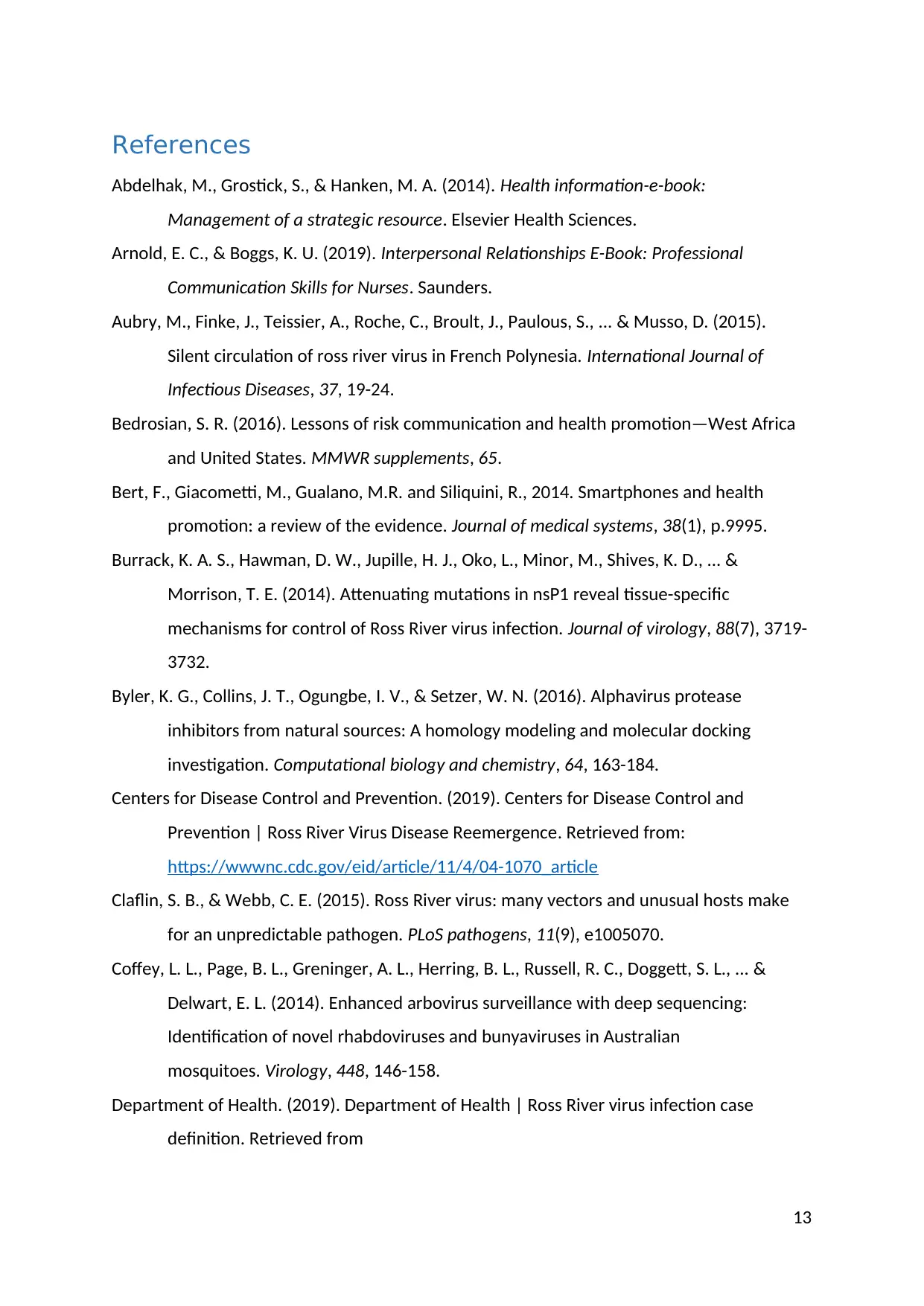
References
Abdelhak, M., Grostick, S., & Hanken, M. A. (2014). Health information-e-book:
Management of a strategic resource. Elsevier Health Sciences.
Arnold, E. C., & Boggs, K. U. (2019). Interpersonal Relationships E-Book: Professional
Communication Skills for Nurses. Saunders.
Aubry, M., Finke, J., Teissier, A., Roche, C., Broult, J., Paulous, S., ... & Musso, D. (2015).
Silent circulation of ross river virus in French Polynesia. International Journal of
Infectious Diseases, 37, 19-24.
Bedrosian, S. R. (2016). Lessons of risk communication and health promotion—West Africa
and United States. MMWR supplements, 65.
Bert, F., Giacometti, M., Gualano, M.R. and Siliquini, R., 2014. Smartphones and health
promotion: a review of the evidence. Journal of medical systems, 38(1), p.9995.
Burrack, K. A. S., Hawman, D. W., Jupille, H. J., Oko, L., Minor, M., Shives, K. D., ... &
Morrison, T. E. (2014). Attenuating mutations in nsP1 reveal tissue-specific
mechanisms for control of Ross River virus infection. Journal of virology, 88(7), 3719-
3732.
Byler, K. G., Collins, J. T., Ogungbe, I. V., & Setzer, W. N. (2016). Alphavirus protease
inhibitors from natural sources: A homology modeling and molecular docking
investigation. Computational biology and chemistry, 64, 163-184.
Centers for Disease Control and Prevention. (2019). Centers for Disease Control and
Prevention | Ross River Virus Disease Reemergence. Retrieved from:
https://wwwnc.cdc.gov/eid/article/11/4/04-1070_article
Claflin, S. B., & Webb, C. E. (2015). Ross River virus: many vectors and unusual hosts make
for an unpredictable pathogen. PLoS pathogens, 11(9), e1005070.
Coffey, L. L., Page, B. L., Greninger, A. L., Herring, B. L., Russell, R. C., Doggett, S. L., ... &
Delwart, E. L. (2014). Enhanced arbovirus surveillance with deep sequencing:
Identification of novel rhabdoviruses and bunyaviruses in Australian
mosquitoes. Virology, 448, 146-158.
Department of Health. (2019). Department of Health | Ross River virus infection case
definition. Retrieved from
13
Abdelhak, M., Grostick, S., & Hanken, M. A. (2014). Health information-e-book:
Management of a strategic resource. Elsevier Health Sciences.
Arnold, E. C., & Boggs, K. U. (2019). Interpersonal Relationships E-Book: Professional
Communication Skills for Nurses. Saunders.
Aubry, M., Finke, J., Teissier, A., Roche, C., Broult, J., Paulous, S., ... & Musso, D. (2015).
Silent circulation of ross river virus in French Polynesia. International Journal of
Infectious Diseases, 37, 19-24.
Bedrosian, S. R. (2016). Lessons of risk communication and health promotion—West Africa
and United States. MMWR supplements, 65.
Bert, F., Giacometti, M., Gualano, M.R. and Siliquini, R., 2014. Smartphones and health
promotion: a review of the evidence. Journal of medical systems, 38(1), p.9995.
Burrack, K. A. S., Hawman, D. W., Jupille, H. J., Oko, L., Minor, M., Shives, K. D., ... &
Morrison, T. E. (2014). Attenuating mutations in nsP1 reveal tissue-specific
mechanisms for control of Ross River virus infection. Journal of virology, 88(7), 3719-
3732.
Byler, K. G., Collins, J. T., Ogungbe, I. V., & Setzer, W. N. (2016). Alphavirus protease
inhibitors from natural sources: A homology modeling and molecular docking
investigation. Computational biology and chemistry, 64, 163-184.
Centers for Disease Control and Prevention. (2019). Centers for Disease Control and
Prevention | Ross River Virus Disease Reemergence. Retrieved from:
https://wwwnc.cdc.gov/eid/article/11/4/04-1070_article
Claflin, S. B., & Webb, C. E. (2015). Ross River virus: many vectors and unusual hosts make
for an unpredictable pathogen. PLoS pathogens, 11(9), e1005070.
Coffey, L. L., Page, B. L., Greninger, A. L., Herring, B. L., Russell, R. C., Doggett, S. L., ... &
Delwart, E. L. (2014). Enhanced arbovirus surveillance with deep sequencing:
Identification of novel rhabdoviruses and bunyaviruses in Australian
mosquitoes. Virology, 448, 146-158.
Department of Health. (2019). Department of Health | Ross River virus infection case
definition. Retrieved from
13
Paraphrase This Document
Need a fresh take? Get an instant paraphrase of this document with our AI Paraphraser
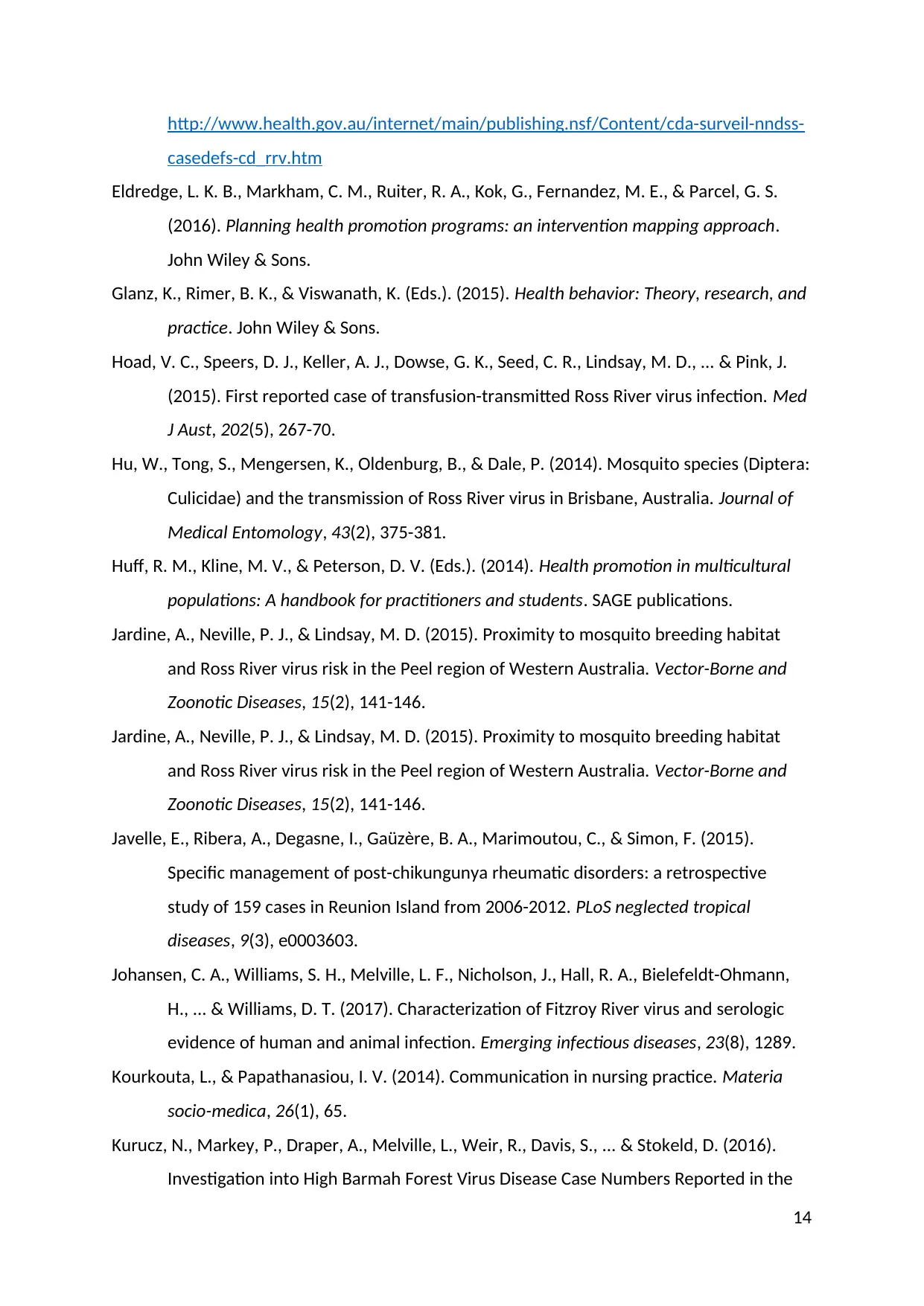
http://www.health.gov.au/internet/main/publishing.nsf/Content/cda-surveil-nndss-
casedefs-cd_rrv.htm
Eldredge, L. K. B., Markham, C. M., Ruiter, R. A., Kok, G., Fernandez, M. E., & Parcel, G. S.
(2016). Planning health promotion programs: an intervention mapping approach.
John Wiley & Sons.
Glanz, K., Rimer, B. K., & Viswanath, K. (Eds.). (2015). Health behavior: Theory, research, and
practice. John Wiley & Sons.
Hoad, V. C., Speers, D. J., Keller, A. J., Dowse, G. K., Seed, C. R., Lindsay, M. D., ... & Pink, J.
(2015). First reported case of transfusion-transmitted Ross River virus infection. Med
J Aust, 202(5), 267-70.
Hu, W., Tong, S., Mengersen, K., Oldenburg, B., & Dale, P. (2014). Mosquito species (Diptera:
Culicidae) and the transmission of Ross River virus in Brisbane, Australia. Journal of
Medical Entomology, 43(2), 375-381.
Huff, R. M., Kline, M. V., & Peterson, D. V. (Eds.). (2014). Health promotion in multicultural
populations: A handbook for practitioners and students. SAGE publications.
Jardine, A., Neville, P. J., & Lindsay, M. D. (2015). Proximity to mosquito breeding habitat
and Ross River virus risk in the Peel region of Western Australia. Vector-Borne and
Zoonotic Diseases, 15(2), 141-146.
Jardine, A., Neville, P. J., & Lindsay, M. D. (2015). Proximity to mosquito breeding habitat
and Ross River virus risk in the Peel region of Western Australia. Vector-Borne and
Zoonotic Diseases, 15(2), 141-146.
Javelle, E., Ribera, A., Degasne, I., Gaüzère, B. A., Marimoutou, C., & Simon, F. (2015).
Specific management of post-chikungunya rheumatic disorders: a retrospective
study of 159 cases in Reunion Island from 2006-2012. PLoS neglected tropical
diseases, 9(3), e0003603.
Johansen, C. A., Williams, S. H., Melville, L. F., Nicholson, J., Hall, R. A., Bielefeldt-Ohmann,
H., ... & Williams, D. T. (2017). Characterization of Fitzroy River virus and serologic
evidence of human and animal infection. Emerging infectious diseases, 23(8), 1289.
Kourkouta, L., & Papathanasiou, I. V. (2014). Communication in nursing practice. Materia
socio-medica, 26(1), 65.
Kurucz, N., Markey, P., Draper, A., Melville, L., Weir, R., Davis, S., ... & Stokeld, D. (2016).
Investigation into High Barmah Forest Virus Disease Case Numbers Reported in the
14
casedefs-cd_rrv.htm
Eldredge, L. K. B., Markham, C. M., Ruiter, R. A., Kok, G., Fernandez, M. E., & Parcel, G. S.
(2016). Planning health promotion programs: an intervention mapping approach.
John Wiley & Sons.
Glanz, K., Rimer, B. K., & Viswanath, K. (Eds.). (2015). Health behavior: Theory, research, and
practice. John Wiley & Sons.
Hoad, V. C., Speers, D. J., Keller, A. J., Dowse, G. K., Seed, C. R., Lindsay, M. D., ... & Pink, J.
(2015). First reported case of transfusion-transmitted Ross River virus infection. Med
J Aust, 202(5), 267-70.
Hu, W., Tong, S., Mengersen, K., Oldenburg, B., & Dale, P. (2014). Mosquito species (Diptera:
Culicidae) and the transmission of Ross River virus in Brisbane, Australia. Journal of
Medical Entomology, 43(2), 375-381.
Huff, R. M., Kline, M. V., & Peterson, D. V. (Eds.). (2014). Health promotion in multicultural
populations: A handbook for practitioners and students. SAGE publications.
Jardine, A., Neville, P. J., & Lindsay, M. D. (2015). Proximity to mosquito breeding habitat
and Ross River virus risk in the Peel region of Western Australia. Vector-Borne and
Zoonotic Diseases, 15(2), 141-146.
Jardine, A., Neville, P. J., & Lindsay, M. D. (2015). Proximity to mosquito breeding habitat
and Ross River virus risk in the Peel region of Western Australia. Vector-Borne and
Zoonotic Diseases, 15(2), 141-146.
Javelle, E., Ribera, A., Degasne, I., Gaüzère, B. A., Marimoutou, C., & Simon, F. (2015).
Specific management of post-chikungunya rheumatic disorders: a retrospective
study of 159 cases in Reunion Island from 2006-2012. PLoS neglected tropical
diseases, 9(3), e0003603.
Johansen, C. A., Williams, S. H., Melville, L. F., Nicholson, J., Hall, R. A., Bielefeldt-Ohmann,
H., ... & Williams, D. T. (2017). Characterization of Fitzroy River virus and serologic
evidence of human and animal infection. Emerging infectious diseases, 23(8), 1289.
Kourkouta, L., & Papathanasiou, I. V. (2014). Communication in nursing practice. Materia
socio-medica, 26(1), 65.
Kurucz, N., Markey, P., Draper, A., Melville, L., Weir, R., Davis, S., ... & Stokeld, D. (2016).
Investigation into High Barmah Forest Virus Disease Case Numbers Reported in the
14
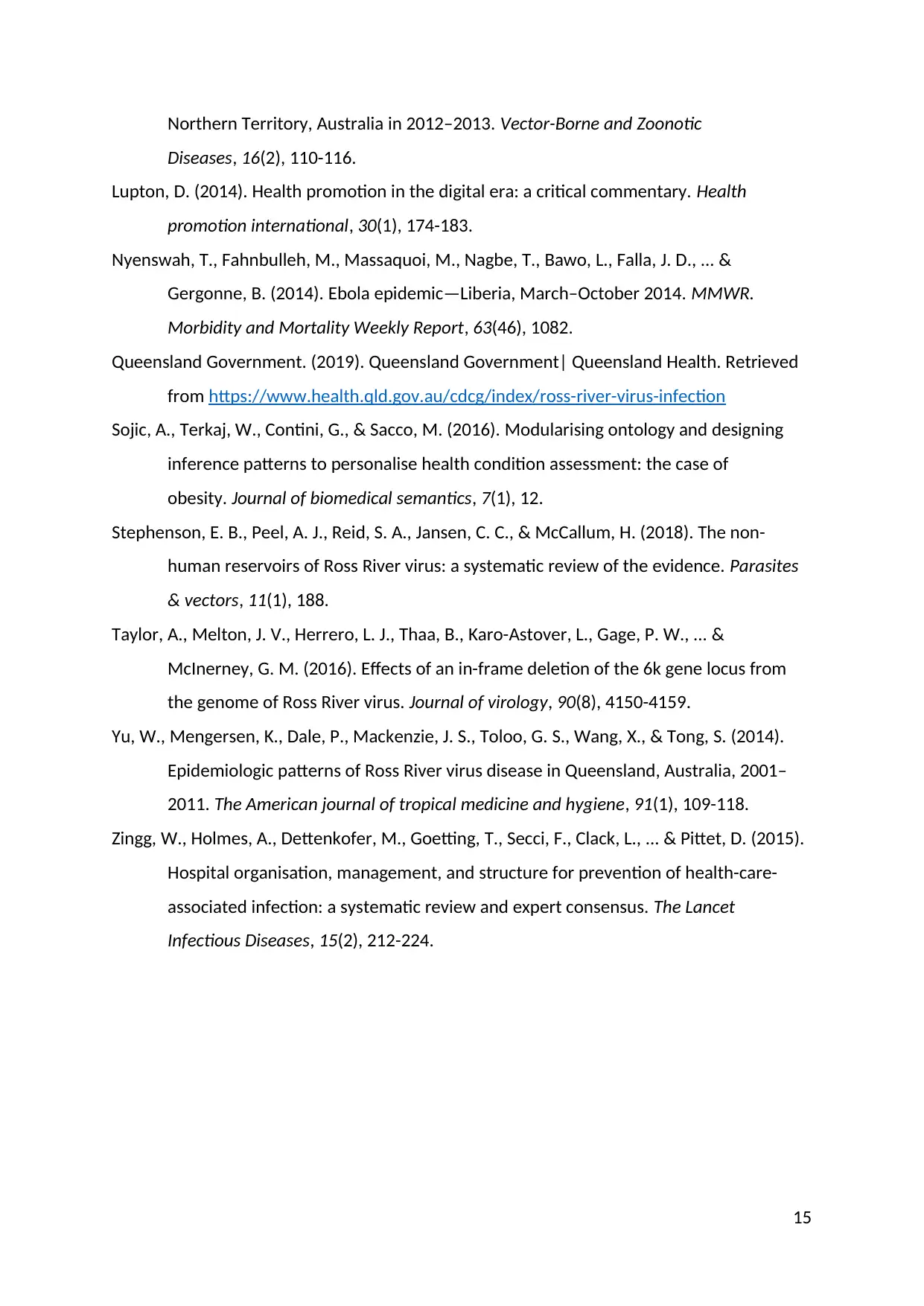
Northern Territory, Australia in 2012–2013. Vector-Borne and Zoonotic
Diseases, 16(2), 110-116.
Lupton, D. (2014). Health promotion in the digital era: a critical commentary. Health
promotion international, 30(1), 174-183.
Nyenswah, T., Fahnbulleh, M., Massaquoi, M., Nagbe, T., Bawo, L., Falla, J. D., ... &
Gergonne, B. (2014). Ebola epidemic—Liberia, March–October 2014. MMWR.
Morbidity and Mortality Weekly Report, 63(46), 1082.
Queensland Government. (2019). Queensland Government| Queensland Health. Retrieved
from https://www.health.qld.gov.au/cdcg/index/ross-river-virus-infection
Sojic, A., Terkaj, W., Contini, G., & Sacco, M. (2016). Modularising ontology and designing
inference patterns to personalise health condition assessment: the case of
obesity. Journal of biomedical semantics, 7(1), 12.
Stephenson, E. B., Peel, A. J., Reid, S. A., Jansen, C. C., & McCallum, H. (2018). The non-
human reservoirs of Ross River virus: a systematic review of the evidence. Parasites
& vectors, 11(1), 188.
Taylor, A., Melton, J. V., Herrero, L. J., Thaa, B., Karo-Astover, L., Gage, P. W., ... &
McInerney, G. M. (2016). Effects of an in-frame deletion of the 6k gene locus from
the genome of Ross River virus. Journal of virology, 90(8), 4150-4159.
Yu, W., Mengersen, K., Dale, P., Mackenzie, J. S., Toloo, G. S., Wang, X., & Tong, S. (2014).
Epidemiologic patterns of Ross River virus disease in Queensland, Australia, 2001–
2011. The American journal of tropical medicine and hygiene, 91(1), 109-118.
Zingg, W., Holmes, A., Dettenkofer, M., Goetting, T., Secci, F., Clack, L., ... & Pittet, D. (2015).
Hospital organisation, management, and structure for prevention of health-care-
associated infection: a systematic review and expert consensus. The Lancet
Infectious Diseases, 15(2), 212-224.
15
Diseases, 16(2), 110-116.
Lupton, D. (2014). Health promotion in the digital era: a critical commentary. Health
promotion international, 30(1), 174-183.
Nyenswah, T., Fahnbulleh, M., Massaquoi, M., Nagbe, T., Bawo, L., Falla, J. D., ... &
Gergonne, B. (2014). Ebola epidemic—Liberia, March–October 2014. MMWR.
Morbidity and Mortality Weekly Report, 63(46), 1082.
Queensland Government. (2019). Queensland Government| Queensland Health. Retrieved
from https://www.health.qld.gov.au/cdcg/index/ross-river-virus-infection
Sojic, A., Terkaj, W., Contini, G., & Sacco, M. (2016). Modularising ontology and designing
inference patterns to personalise health condition assessment: the case of
obesity. Journal of biomedical semantics, 7(1), 12.
Stephenson, E. B., Peel, A. J., Reid, S. A., Jansen, C. C., & McCallum, H. (2018). The non-
human reservoirs of Ross River virus: a systematic review of the evidence. Parasites
& vectors, 11(1), 188.
Taylor, A., Melton, J. V., Herrero, L. J., Thaa, B., Karo-Astover, L., Gage, P. W., ... &
McInerney, G. M. (2016). Effects of an in-frame deletion of the 6k gene locus from
the genome of Ross River virus. Journal of virology, 90(8), 4150-4159.
Yu, W., Mengersen, K., Dale, P., Mackenzie, J. S., Toloo, G. S., Wang, X., & Tong, S. (2014).
Epidemiologic patterns of Ross River virus disease in Queensland, Australia, 2001–
2011. The American journal of tropical medicine and hygiene, 91(1), 109-118.
Zingg, W., Holmes, A., Dettenkofer, M., Goetting, T., Secci, F., Clack, L., ... & Pittet, D. (2015).
Hospital organisation, management, and structure for prevention of health-care-
associated infection: a systematic review and expert consensus. The Lancet
Infectious Diseases, 15(2), 212-224.
15
1 out of 15
Related Documents
Your All-in-One AI-Powered Toolkit for Academic Success.
+13062052269
info@desklib.com
Available 24*7 on WhatsApp / Email
![[object Object]](/_next/static/media/star-bottom.7253800d.svg)
Unlock your academic potential
© 2024 | Zucol Services PVT LTD | All rights reserved.





